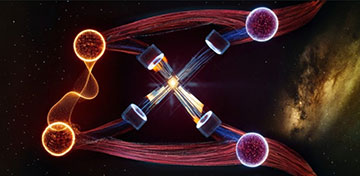
Artist’s impression of the new photonic experiment, which uses the entanglement between photons’ polarization as a stand-in for gravity-mediated entanglement. [Image: Federico Alfano]
Despite decades of work on quantum gravity, physicists have yet to find any experimental evidence showing gravity's quantum-mechanical nature. But now an Italian-led group of researchers has used a photonic simulator to show how an effect known as gravity-mediated entanglement might be measured in the future (Adv. Photon. Nexus, doi: 10.1117/1.APN.3.3.036011). This could either provide empirical backing for quantum gravity or rule out all mainstream theories attempting to explain it.
Quantum mechanics versus general relativity
Reconciling quantum mechanics and general relativity remains one of the great outstanding challenges of modern physics. Scientists have developed a number of theories that attempt to unify the two, including string theory and loop quantum gravity. But none of these proposals has had backing from laboratory or observational research.
Other researchers, such as mathematical physicist Roger Penrose, have put forward alternative theories in which quantum mechanics breaks down for large masses because it is energetically unfavorable for their wavefunctions to exist in a superposition―an objective rather than observer-dependent process. Such a process, if true, would leave a characteristic signature in superpositions of suitably large systems―a fact that, combined with ever-greater experimental control of macroscopic systems, has generated renewed interest in low-energy tests of quantum gravity.
The test investigated in the latest work is one based on the concept of gravity-mediated entanglement (GME). The idea is to provide evidence for the superposition of a gravitational field by detecting the entanglement that such a field would produce when masses held in superpositions interact gravitationally.
More specifically, two masses would each contain an isolated spin in the form of a nitrogen-vacancy center and be exposed to an inhomogeneous magnetic field, placing them in a superposition of spin states. The masses would be dropped from a certain height such that the freefall paths of one spin state from each mass would come into very close contact and thereby interact with one another gravitationally. With the magnetic field then turned off, the two collapsed spins would be measured to reveal any entanglement caused by a phase difference between the masses' different branches in freefall.
Such a setup cannot yet be operated with sufficient sensitivity to detect the entanglement. So in the meantime, some groups are investigating photonic proxies to try and work out how best to build and operate the real thing once technology has improved.
Toward measuring GME
The idea is to provide evidence for the superposition of a gravitational field by detecting the entanglement that such a field would produce when masses held in superpositions interact gravitationally.
Emanuele Polino at the University of Rome "La Sapienza" and colleagues in Italy, Austria, and Canada have done so by simulating the spins' orientation and gravitational field using the polarization and paths of two infrared photons, respectively. They prepare each photon in a superposition of horizontal and vertical polarizations and then simulate the effect of a gravitational interaction using a beam splitter to entangle the paths of the two photons. Finally, they recombine the paths of each photon and measure the particles' polarizations.
To show that they could provide evidence of entanglement at the measurement stage―and thereby eventual GME in a matter-based experiment―they used three different methods: quantum state tomography, an entanglement witness and a Bell inequality violation. As they explain, each approach has its strengths and weaknesses. They found that they could best measure the presence of entanglement using a Bell test but argue that tomography would instead be needed to ascertain entanglement's absence―having simulated and distinguished between decoherence due to unknown physics and to noise by introducing time delays across different polarizations.
As they point out, the latter result would come as a huge shock, and physicists would likely not accept it unless "extraordinary evidence" were available. Hence the need for state tomography, which provides the most complete description of a spin's quantum state. "This measurement would be of extraordinary consequence for fundamental physics," they say, "upending convictions held by generations of theoretical physicists."
However, says Polino, going from the latest research to a test of actual GME will require technological advances in order to create long-lived superposition states of large masses.

